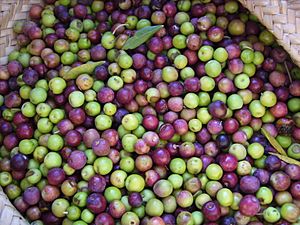Arbequina facts for kids
Quick facts for kids Arbequina |
|
|---|---|

Arbequina olives just after harvest
|
|
| Olive (Olea europaea) | |
| Origin | Spain |
| Use | Oil and table |
Arbequina is a special type of olive tree. It produces small, round olives that are dark brown when ripe. These olives are very fragrant and are used for both making delicious olive oil and for eating.
Arbequina olives are mostly grown in Catalonia, Spain, where they first became popular. But you can also find them in other parts of Spain like Aragon and Andalusia. Beyond Spain, they are grown in many other countries, including California in the USA, Argentina, Chile, Australia, and Azerbaijan. Recently, Arbequina has become one of the most common olive types grown worldwide, especially on large, modern farms.
Contents
Where the Name Comes From
The name Arbequina comes from a small village in Spain called Arbeca. This is where the olive tree was first brought to Europe in the 1600s. It came from the Ottoman Empire, introduced by a Spanish nobleman called the Duke of Medinaceli. From there, it spread and became one of the most widely planted olive types in the world.
Where Arbequina Olives Grow
Arbequina olives are grown in many different countries around the globe. You can find them in places like Albania, Algeria, Argentina, and Australia. In Brazil, they grow in the state of Paraná. Chile also grows them in areas like Arica and Limari.
Other countries where Arbequina olives are farmed include Egypt, France, Iran, Israel, Libya, and Mexico. In Peru, they are grown in Arequipa and Moquegua. Of course, they are very popular in Portugal and Saudi Arabia. In Spain, they are grown in many regions, including Catalonia, Andalusia, and Aragon. They are also found in South Africa, Turkey, and the United States.
How Arbequina Trees Grow
Arbequina olive trees can grow well in many different climates and types of soil. They prefer soils that are a bit alkaline (not too acidic). They really like long, hot, and dry summers. However, they are also tough and can handle cold weather and common plant pests.
These trees are quite small, which makes them perfect for modern, high-density olive farms. This means many trees can be planted close together. Arbequina trees start producing olives early, usually around the first half of November. The olives don't all ripen at the same time, but they are not too hard to pick.
What's special about Arbequina is that its seeds sprout easily. This makes it a popular choice for growing new olive trees from scratch. In fact, a large number of olive farms in California use Arbequina as the base plant for their trees.
Using Arbequina Olives
Arbequina olives are mostly used to make olive oil because they have a very high oil content. It's easy to harvest them because the trees are usually low to the ground, so you can pick them by hand.
The oil made from Arbequina olives is usually smooth, fruity, and has a very mild flavor. It's often described as tasting "buttery." This oil has lower levels of certain natural plant chemicals called polyphenols compared to other olive oils. It also has higher levels of healthy fats called polyunsaturated fats. Because of this, Arbequina olive oil is best used fairly quickly, as it doesn't stay fresh as long as some other types of olive oil.
New Olive Varieties
Scientists have even used Arbequina olives to create new types of olive trees! By crossing Arbequina with another olive type called Picual, they created a new variety known as Chiquitota.
See also
 In Spanish: Arbequina para niños
In Spanish: Arbequina para niños


